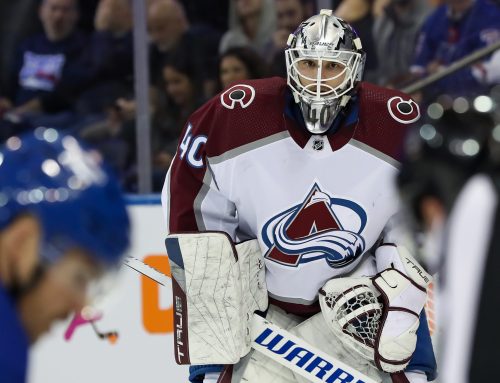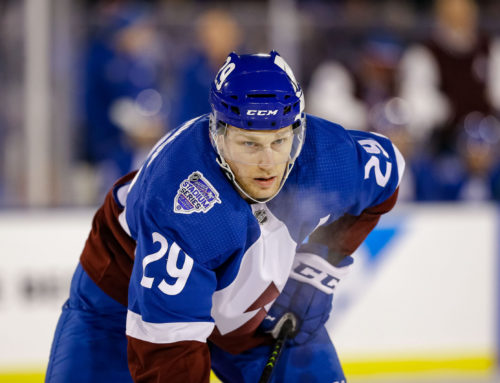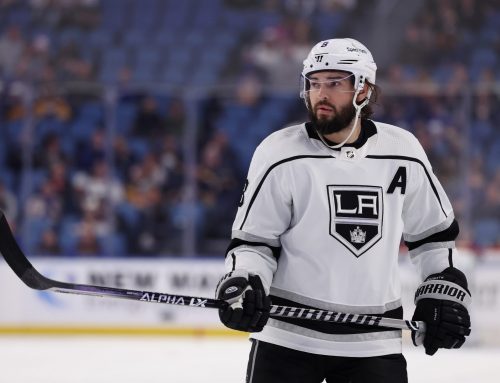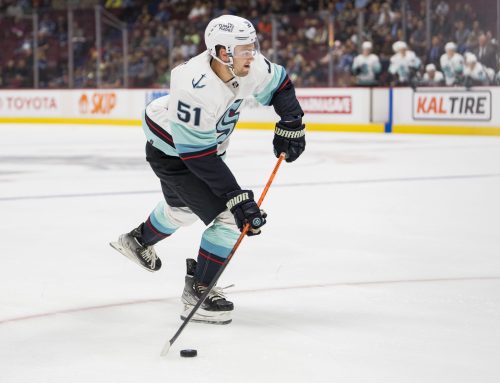Six Players in the West Who Will Decline
Doran Libin
2015-09-28

Libin offers up six players in the Western Conference looking at declining numbers.
For much of the same reasons that identifying a player on the rise or ready to break out is of immense value to a poolies, identifying a player on the decline, or a player primed to regress, is invaluable. Getting rid of a player when their value is at its peak is the surest way to maximize value, knowing when that peak has occurred is the hard part. Here are six picks, one is a package deal, to sell before their value dips.
Lance Bouma – Forward, Calgary
Bouma scored 16 goals last year despite just over a shot per game. His goal total last year nearly tripled his previous career total in only 78 games. The only thing that really changed for Bouma last year was his shooting percentage as his shot rate was fairly consistent to his career rates heading into the season. Furthermore after never having finished with a shooting percentage of even seven percent he finished last year with a shooting percentage of over 15 percent. If Bouma scores on half as many of his shots that is eight fewer point on the season, but there is reason to worry aside from just his elevated shooting percentage. The main reason is that Bouma’s success was heavily dependent on his playing with Mikael Backlund. Before Backlund’s return from injury last season Bouma played with Matt Stajan, together they were on the ice together for 2.26 goals for per 60 minutes. In comparison when Bouma skated with Backlund he was on the ice for 2.82 goals for per 60 minutes, the difference, given Bouma’s minutes, equates to him being on the ice for an extra goal every six games. It makes sense given that when playing with Backlund Bouma is on for fewer shots against and more shots for. With Frolik and Bennett factoring into the lineup this year Bouma will be in tough to keep his second line spot. With less ice time and the bite of regression Bouma likely does not hit 20 points.
Troy Brouwer – Forward, St Louis
It would be easy to point to Brouwer’s high shooting percentage last year (12.7%) as a reason to expect regression except for the fact that it was his lowest shooting percentage in the last six years. Brouwer’s elevated shooting percentage is related to where he shoots from, namely in front of the net, as opposed to him being especially ‘lucky’. The reason for expecting Brouwer’s production to fall is because of the effects of him moving to St Louis from Washington. Namely he goes from Washington where he routinely got more three minutes of power play time per game to a team loaded up front where he will be hard pressed to match that sort of usage. In Washington there was a spot open for him on the power play it is something of a different story in St Louis where Paul Stastny received the sixth most power play time as a forward at just under two and a half minutes, with only Alex Steen the only forward getting more than three minutes. That slots Troy Brouwer as the seventh forward on the Blues power play, having to battle Dmitri Jaskin and Patrik Berglund for that spot. Combine the reduction in power play minutes with the potential for Brouwer to skate on the third line and a drop of 10 points or more looks exceedingly likely.
The Sedins – Forwards, Vancouver
Henrik and Daniel Sedin rebounded last year from around two points per 60 minutes in 2013/14 back to around three points per 60 minutes last season. That could just be a correction from an unusually low on-ice shooting percentage in 2013/14 to something within their normal range of 10% or higher. There is an outlier, however, in their numbers as they each had seven empty net points after having never scored more than four empty net points in a season. That number of empty net points stands out even more given that they combined for two empty net points over the last three seasons. Given the way goalies are pulled now, earlier and more often, it is possible that the jump in empty net points is simply in line with new league strategies but if that was the case there should be a big jump in their empty net minutes as well, which did not occur last season. Aside from the jump in empty net points, which likely accounted for between three and five points, the Sedins also had a banner year on the power play. This was due to the Canucks power play returning to the top 10 of the league’s power plays after two years of the power play lurking around 15%. For the Sedins to each produce close to 25 power play points this season the Canuck power play needs to keep clicking at close to 20%. Given the last two seasons it seems to be a much safer bet that they will not do so. Look for the Sedins to be closer to 65 than 75 points.
Trevor Daley – Defense, Chicago
Daley had a career high 38 points last season while playing nearly 23 minutes per game with a shooting percentage of nearly 15%. Even if Daley was not switching teams there is almost no way he repeats that shooting percentage given that his previous high was 7.9%, meaning last season was only the second time he had a shooting percentage greater than seven percent in his career. The change of scenery will play a big factor as well in Daley failing to repeat last season’s success. First, he will not get the power play time that he got in Dallas as only Keith and Seabrook got any significant power play time among Chicago defensemen last season. As such Daley will be lucky to get anywhere near the almost three minutes per game of power play minutes he received last year. With a near certain significant reduction in power play minutes Daley will fail to match the 12 power play points he produced last season, double his previous career high. The reduction in shooting percentage should account for six points and the reduction in power play minutes should mean another five point drop for Daley, putting him at 27 for next year. Count on an even greater drop if Daley gets used in the same defensive fashion that Oduya was deployed in Chicago. In that role neither Hjalmarsson nor Oduya reached 20 points last year, and Hjalmarsson is the only one of the two reach 20 points in the last three non-lockout seasons in Chicago. That being the case, unless the pair of Seabrook and Keith is split up look for Daley to finish with less than 25 points.
Kevin Shattenkirk – Defense, St Louis
Shattenkirk had an amazing run on the St Louis power play last year while he was healthy. He put up 25 points in 54 games almost equaling his output from the 2013/14 season despite playing 27 fewer games. The prolific rate at which the Blues scored with him on the power play, a 19.6% on-ice shooting percentage, resulted in Shattenkirk putting up points at a rate of 7.7 points per 60 minutes of power play time. In the previous three seasons the Blues never scored on more than 15% of their shots while him was on the ice. Both the on-ice shooting percentage and his points per 60 were ridiculous and should fall. As Shattenkirk was not involved in an abnormally large percentage of the Blues’ power play goals his production drop should be proportional to the drop for the Blues as a whole. Furthermore, no defenseman has had multiple seasons with over six points per 60 minutes on the power play in the last six years, which goes to show the insane rate at which Shattenkirk was racking up power play points. That being the case he would have between five and 10 fewer power play points over the span that Shattenkirk was healthy. In all Shattenkirk will get more points than last he did last season, so he is a bit of an outlier in the column, but he will produce points at anything near the rate he did last season. He was on pace for 66 points last season, which could drop by as many as 15 points for this coming season.
Follow Doran Libin on Twitter
5 Comments
Leave A Comment
You must be logged in to post a comment.





 MIN
MIN SEA
SEA WPG
WPG VAN
VAN CGY
CGY S.J
S.J COL
COL EDM
EDM VGK
VGK ANA
ANA L.A
L.A CHI
CHI MTL
MTL TOR
TOR PIT
PIT NYI
NYI WSH
WSH CBJ
CBJ ARI
ARI BUF
BUF

I'm confused on Shattenkirk – how does one rack up PP points without being involved in the PP goals?
I don't have either Twin getting 80 points again, but with the new 3 on 3 OT, I could see them getting close to what they did last year. Shattenkirk should have a similar output as last year for the same reason.
Chicago lost 2 players in Sharp (PP1) and Richards (PP2) who played on the point on the PP last season. Daley should pick up one of those two spots. While his PP time will probably decrease it won't be as much of a decline as the author inidcates.
Shattenkirk's rate of production will decline not his overall production. This will happen largely because the Blues won't score on 20% of their pp shots when he's on the ice. If his PP IPP was ridiculously high the expected ecline would be even greater.
As for Daley he won't get first unit power play minutes, maybe second unit at best. If a defenseman is going to get more power play minutes it will be Seabrook, and Daley will be relegated to the second unit at best. Either way he's not putting up 12 PP points this year.